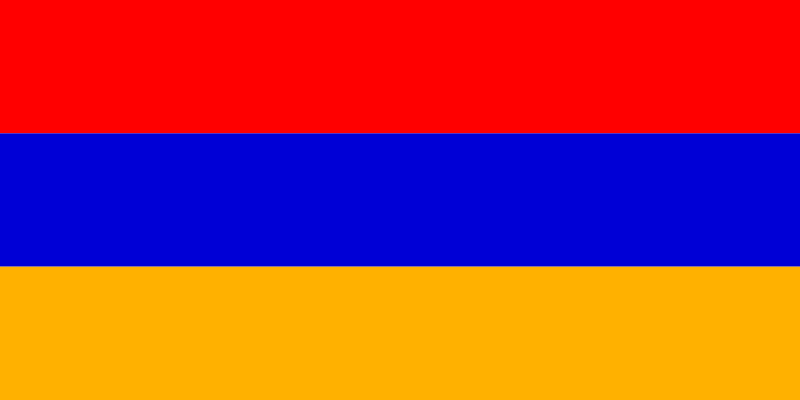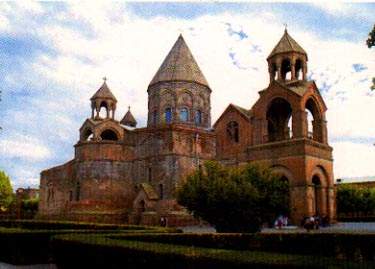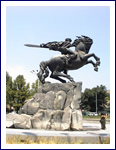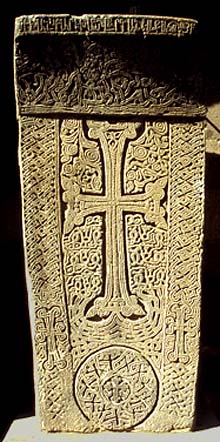
Official Name: Republic of Armenia.
Capital: Yerevan.
National Holiday: September 21st 1991, Independence Day from the Soviet Union
Government type: Republic.
Administrative Division: 11 provinces.
President: Serzh Sarsyan.
Location: Southwestern Asia
Territory Size: 29,743 sq km
Border Countries: Azerbaijan, Azerbaijan, Georgia, Iran and Turkey.
Population: 2,967,004 (July 2009 est.)
Ethnic Group(s): Armenian 97.9%, Yezidi (Kurd) 1.3%, Russian 0.5%, other 0.3% (2001 census)
Religion(s): Armenian Apostolic 94.7%, other Christian 4%, Yezidi (monotheist with elements of nature worship) 1.3%.
Language(s): Armenian 97.7%, Yezidi 1%, Russian 0.9%, other 0.4%
Economy
Natural Resources: small deposits of gold, copper, molybdenum, zinc, and bauxite.
Industry: diamond-processing, metal-cutting machine tools, forging-pressing machines, electric motors, tires, knitted wear, hosiery, shoes, silk fabric, chemicals, trucks, instruments, microelectronics, jewelry manufacturing, software development, food processing, brandy
Agriculture: fruit (especially grapes), vegetables; livestock.
Exports: pig iron, unwrought copper, nonferrous metals, diamonds, mineral products, foodstuffs, energy and others.
Imports: natural gas, petroleum, tobacco products, foodstuffs, diamonds, among others.
Know a Little bit about Armenia
It was the first State into adopts Christianity during the 4th century. After years of autonomy, Armenia came under domination of several empires like the Roman, Byzantine, Arab, Persian, and Ottoman. The eastern side was given to Russia in 1828, declared their independence in 1918 and was conquered by the red army in 1920.
The World War I period established the forced resettlement coupled and other harsh practices into the western side of the territory by the Ottoman Turkey Empire, and almost one million Armenian were killed.
In 1988 Armenia and Azerbaijan began fighting over Nagorno-Karabakh and still fight for it. The economies of both sides have been hurt by their inability to make substantial progress toward a peaceful resolution.
One of the world's oldest civilizations,
 Armenia once included Mount Ararat, which biblical tradition identifies as the mountain that Noah's ark rested on after the flood. It was the first country in the world to officially embrace Christianity as its religion (c. 300).
Armenia once included Mount Ararat, which biblical tradition identifies as the mountain that Noah's ark rested on after the flood. It was the first country in the world to officially embrace Christianity as its religion (c. 300).
In the 6th century b.c.e., Armenians settled in the kingdom of Urarty (the Assyrian name for Ararat), which was in decline. Under Tigrane the Great (fl. 95-55 c.c.e.) the Armenian empire reached its height and became one of the most powerful in Asia, stretching from the Caspian to the Mediterranean Seas. Throughout most of its long history, however, Armenia has been invaded by a succession of empires. Under constant threat of domination by foreign forces, Armenians became both cosmopolitan as well as fierce protectors of their culture and tradition.
Over the centuries Armenia was conquered by Greeks, Romans, Persians, Byzantines, Mongols, Arabs, Ottoman Turks, and Russian. From the 17th century through World War I major portions of Armenia were controlled by their most brutal invader, the Ottoman Turks, under whom they experienced discrimination, religious persecution, heavy taxation, and armed attacks. In response to Armenian nationalist stirrings, the Turks massacred thousands of Armenians in 1894 and 1896. The most horrific massacre took place in April 1915 during World War I, when the Turks ordered the deportation of the Armenian population to the deserts of Syria and Mesopotamia. According to the majority of historians, between 600,000 and 1.5 million Armenians were murdered or died of starvation. The Armenian massacre is considered the first genocide in the 20th century. Turkey denies that a genocide took place, and claims that a much smaller number died in a civil war.

After the Turkey defeat in World War I, the independent Republic of Armenia was established on May 28, 1918, but survived only until Nov. 29, 1920, when it was annexed by the Soviet Army. On March 12, 1922, the Soviets joined Georgia, Armenia, and Azerbaijan to form the Transcaucasian Soviet Socialist Republic, which became part of the USSR. In 1936, after reorganization, Armenia became a separate constituent republic of the USSR. Since 1988, Armenia has been involved in a territorial dispute with Azerbaijan over the enclave of Nagorno - Karabagh, to which both lay claim. Also in 1988, a devastating earthquake killed thousands and wreaked, economic havoc.

Armenia declared its independence form the collapsing Soviet Union on Sept 23, 1991.
An Armenian Diaspora has existed throughout the nation's history, and Armenian emigration has been particularly heavy since independence from the Soviet Union. An estimated 60% of the total eight million Armenians worldwide live outside the country, with one million each in the U.S. and Russia. Significant Armenian communities are located in Georgia, France, Iran, Lebanon, Syria, Argentina, and Canada.
What One Can See in Armenia

Armenia occupies a territory of 2977 thousand square kilometers. The average altitude of the territory is 1,800 meters above the sea level, the highest peak has an altitude of 4,090 meters and the lowest point is ravine of Debet with an altitude of 380 meters.
Armenia occupies a part of in the chain of the mountains which is called the Armenian Plateau. It is situated within the Alps-Himalayas mountain system and can be called "an island of mountains"
While flying in a plane over the Armenian Plateau you will see an endless chain of mountains, lakes hidden in the heights, mountain torrents and waterfalls, valleys, isolated highlands. Among all these Lake Sevan unveils Itself with constantly changing colors - either matching the sky in a harmony or contrasting itself to the sky blue. It is almost a sin to be in Armenia and not to see Lake Sevan or swim in it or wander around it. Sevan is a lake of mysteries. It is located ed at an altitude of 1,900 meters above the sea level, the maximum depth is 99 meters, there is a peninsula which was an island some decades ago, 28 rivers merge in it while only one - Hrazdan flows out of it.
On the territory of Armenia there are 10 natural lakes, 15 swift rivers, 5 canyons which form a common lacework of high and low peaks.
Come to this Promised Land where you can see man-made miracles next to the natural wonders. The embroidery of crosses carved in the cliffs continues the natural genesis. Or have a look at the monastery of Geghard located in a dark ravine. For centuries the artisans struggled against the stones and created a monument carved in the cliffs as if no human hand has ever touched it. In most picturesque places in the mountains chiseled by thick forests or deep ravines you can find scattered but interconnected by some inner logic architectural master- pieces like ensemble of Haghartsin monastery (X-XIII A.D.), Goshavank (X-XIII A.D.), Kecharis (XI-XX A.D.), the complexes of Sanahin and Haghpat (X-XX A.D.), Odzun (VI-VII A.D.), Marmashen (IX-XIII A.D.), fortress of Lori and its inner
town (II millennium B.C. -XVII A.D.), Hnevank (XII-XIII A.D.). If you wish to walk
and have adventurous sensations you can go down a canyon and then raise your head. You will see a chain of inaccessible fortresses dipped in sunrays which are like have grown out of cliffs and are hung in the air. You can climb through the
paths to fortresses Amberd (VII-XV A.D.), Halidzor (XVII A.D.), Baghaberd (V
A.D.), Garni (I B.C.) and you will feel the spirit of centuries, the flight of human thought and the power of its domination over the nature.
This country of lakes, rivers and springs is also rich of mineral waters. In Jermuk, Bjni, Dilijan and other resorts you can treat different diseases by taking a bath in mineral waters. The waterfall of Shaki is one of the aquatic beauties of Armenia, which, splitting the chest of cliffs, falls from an altitude of 18 meters into the ravine and flows into the river Vorotan which passes through Siunik and joins the river Araks.
Step into the virgin forests of Armenia where you can see different animals and birds. You can go hunting, just try and probably you will not be disappointed.
Armenia is beautiful not only in summer but also in winter when the mountains and valleys are covered with snow. In Tsakhkadzor town by an aerial cable way you can go up to the top of Mount Teghenis, contemplate the magnificence of the highland, have a cup of oriental coffee prepared on hot sand and ski down the mountains. The Shirak valley can also offer you winter sport opportunities.
In valleys and particularly on the shore of Sevan or on the banks of Araks you can watch the transmigration of birds in spring and fall, enjoy the singing of flamingos and storks of different species and colors.
Walk the streets of Armenian towns that are full of greenery. Each of them is like a garden where you can extend your hand and pick up a mulberry or a cherry, a peach or an apricot. Each town has its own legend and history, its date of establishment. This is not an exaggeration; some of the trees in the streets are fruit-trees. For instance, Yerevan' 13th capital of Armenia - will become 2780 years old in 1998, it is even older than Cartagena. Yerevan is nice with its old and new buildings, broad streets, large and small museums and exhibitions. If you wish to see the whole of Yerevan you have to go up to Victory park and the whole city will be seen spread at the foot of gorgeous Ararat. If you strain your imagination just a little you will notice the Noah's Ark in the snows of Ararat. Humankind was reborn here, populated this valley and on the territory of Armenia Christianity was adopted as a state religion for the first time.
Cultural Heritage

You can gain further insights into Armenian cultural achievements at museums, theaters and concert halls. Theater in Armenia has a tradition dating back more than 2,000 years. You can attend a wide choice of performances ranging from concerts to puppet theater and jazz music.
At the top of Mesrop Mashtots Avenue, the main artery of the capital city Yerevan, you will find the Matenadaran - the Institute of Ancient Manuscripts. Matenadaran boasts the world's largest collection of ancient manuscripts (over 16,000). The collection includes many valuable works of foreign philosophers, some of which have survived only in their Armenian translation. Among these are works by Aristotle, Eusebius of Caesarea and many others. Art aficionados can visit the National Art Gallery displaying its rich collections of works by European and Russian artists. This impressive building located in the Republic Square is also home to the largest national collection of paintings by famous Armenian artists such as Ayvazovsky and Sarian. The spirit of creativity is fostered and promoted in Armenians from the young age. Hence, the Children's Art Gallery, which was the first permanent exhibition of its sort in the world. It is conveniently located at 13 Abovian street, one of the better preserved streets of old Yerevan.
The Alexander Spendiarian Opera and Ballet Theater, one of the principal features of Freedom Square, the design of which is based on the seventh century Cathedral at Zvarnotz consists of a splendid concert hall in addition to the opera house The homes of many famous Armenian writes, poets, and artists are now open to tourists. Their hours of operation vary, so please phone in advance.
Enjoy a leisurely stroll around Yerevan and take in its unique architectural vistas. Yerevan's architectural character stands out in that of the most of the buildings are constructed of various colors of tufa and basalt, both of them products of volcanic nature. This makes Yerevan one of the few cities with no painted buildings.
The city is enshrined with many internationally acclaimed statues by famous sculptors, such Yervand Kochar, Levon Tokmadjian. Most of the statues depict Armenian national heroes or glorify events of national importance.
The Armenian Church

The Armenian Church is an independent Christian church, also known as the Armenian Apostolic Orthodox Church. Its head is the Catholicos, who resides at Holy Etchmiadzin, near Yerevan, the capital of Armenia.
Christianity was declared the state religion of Armenia in AD 301. Armenia thus became the first nation to adopt Christianity as a state religion. This was largely due to the efforts of St. Gregory the Illuminator. Born a nobleman, he converted Armenia's king Tiridates III, who had formerly perse-cuted the Christians. Conversion of the rest of the population soon followed. It was St. Gregory who built the Mother Church at Etchmiadzin in AD 303.
Until the 5th century, Christian worship in Armenia was conducted in Greek or Syriac, since there was no Armenian alphabet, hence no written language. In AD 404, St. Mesrob (at that time a monk) completed an alphabet of 36 letters. His objective was to translate the Bible into Armenian, and the golden age of classical Armenian literature began shortly thereafter.
Persia reduced Armenia to vassaldom and in AD 450 issued a decree ordering all Christians to embrace the Zoroastrian religion. The Armenians, under Prince Vartan Mamigonian, rose in revolt. This culminated in the Battle of Avarayr. Vartan lost the battle, but under the leadership of his nephew, Vahan, the Armenians continued the war for 30 years. They won a decisive victory through a peace accord in AD 484, and Armenian Christianity survived. St. Vartan Day-which is celebrated in February of each year-commemorates the battle and is a major Armenian holiday.
The Armenian Church has traditionally maintained two patriarchates: one in Jerusalem and another in Istanbul. In Jerusalem, the Armenian Patriarchate is the guardian of the Holy Places in the possession of the Armenians. It is also one of the three principal custodians of the Church of the Holy Sepulchre and other important shrines and sanctuaries in the Holy Land. The Patriarchate of Constantinople serves a community of approximately 50,000 Armenians living in Istanbul.
Holy Etchmiadzin remains the central spiritual authority for millions of Armenian Christians living in diaspora communities around the globe. In recent years, the Armenian Church has taken an active role in the ecumenical dialogue among the clergy of all faiths.
The Church entered its most recent era of leadership on October 27, 1999, when Armenian Christians elected His Holiness Karekin II as the 132nd Supreme Patriarch and Catholicos of All Armenians, pontiff of the worldwide Armenian Church. He succeeded the deceased Catholicos Karekin I, who died in late June 1999 after leading the church for 4 years.
Holy Etchmiadzin & St. Gregory the Illuminator
The Mother See of Holy Etchmiadzin is the pre-eminent center of authority in the worldwide Armenian Apostolic Church. Located near the capital of Yerevan in the Republic of Armenia, it is composed of (a) the Mother Cathedral of the entire Armenian Church; (b) a monastery and monastic brotherhood; (c) the residence of the Catholicos of All Armenians; and (d) various religious and cultural institutions, such as the Kevorkian Theological Seminary and a museum.
The cathedral dates back to the 4th century, and is reckoned the oldest Christian cathedral in world. Although the current sanctuary was erected in the 1600s, remnants of the 4th-century altar have been unearthed beneath the present structure.
In its capacity as the residence of the Supreme Patriarch and Catholicos (the pontiff of the Armenian Church) of All Armenians, Holy Etchmiadzin is known as the “Catholicate of All Armenians.” It became the seat of the Catholicate of the entire Armenian nation in the 4th century, following the conversion of King Tiridates III to Christianity by St. Gregory the Illuminator in ad 301.
According to the chronicler Agathangelos, soon after Armenia’s conversion to Christianity, St. Gregory had a vision of the Son of God. Appearing as a heroic figure of light surrounded by a mighty angelic host, Christ struck the ground with a golden hammer, indicating the place where the Mother Cathedral of the new Christian nation was to be established. The name Etchmiadzin—literally, “where the Only Begotten descended”—refers to this episode.
Gregory was formally designated as the supreme head of the Church, and was sent to Caesarea to be ordained a bishop. He thus became the first in an unbroken line of 131 catholicoi (or “universal bishops”) of the Armenian Church. He built the first Christian cathedral in Vagharshapat, near Mount Ararat, then the capital of Armenia. Having accomplished his mission and advanced in age, he then retired from active life to live as a hermit until his death.










